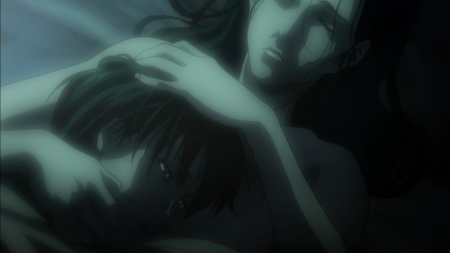Ask John: How Common is Sex in Anime?
Question:
I have seen some anime like the old school and some new ones one like Dragon Ball, Macross, Robotech, Bleach, One Piece, Bubblegum Crisis, D-Gray Man just to name a few. Then one of my friends recommended me to watch Speed Grapher and Gantz. To my impression when I first saw them I thought it would be one of those action drama stuff but then in the following episodes it showed some sex scenes. I was “what the!?” So my two questions are: what kind of category do they fit in and are those the only two that have ever been showed that?
Answer:
Although its prevalence has varied through the years, nudity has been commonplace in anime since the early 1970s. Sexuality and reference to sex in anime goes back even farther, to very early modern anime like 1963’s Sennin Buraku, Japan’s fourth TV anime series (following Otogi Manga Calendar, Tetsuwan Atom, and Ginga Shonentai). The depiction of full sexual intercourse in TV anime, however, is a relatively recent development and still a rather uncommon one. Home video anime has been depicting graphic sex since 1984, but graphic sex in TV anime has remained largely taboo because TV anime is accessible to a much larger and diverse audience.
In 1995 the Shin Seiki Evangelion television series included a sequence in which sex occurred off screen, but viewers could hear the act in progress. Partly because that clear suggestion of sex, at the time, pushed the envelope of what was considered appropriate for TV broadcast anime, and because Evangelion was broadcast during prime-time hours when young children would be watching the show, the scene caused great controversy and, according to legend, nearly got the show pulled from broadcast. Gainax, the studio that animated Evangelion, almost pushed the envelope farther in its next production, 1998’s Kareshi Kanojo no Jijou. While the show broadcast on Japanese television was chaste, the home video version of episode 18 tastefully depicted sex through a series of eight still frames. Gainax did, in fact, put sex on screen in TV anime in 1999. The Oruchuban Ebichu segment of its Anime Ai no Awa Awa Hour television anime anthology included comical scenes of graphic intercourse.
The 2004 Gantz TV series is noteworthy for again pushing the envelope. The Gantz ~The First Stage~ TV series aired on the terrestrial Fuji TV network. It included nudity and violence, but no graphic sex. The amount and intensity of violence and sexuality present in the Gantz story forced the second half of the series, Gantz ~The Second Stage~, off of the Fuji TV network, onto the Animax premium satellite TV network which had more freedom to air provocative content. The second episode of the “Second Stage” included a brazen sex scene, establishing a new, but little used, standard for acceptable content in broadcast Japanese television anime. Unlike Oruchuban Ebichu, which depicted its sex humorously with very stylized art design, the sex scene in Gantz episode 15 is shockingly realistic and primal.
Typically on-screen sexual intercourse has been limited to appearances only in anime TV series broadcast late at night and intended for adult viewers. One memorable exception is the March 2004 broadcast of the second Mobile Suit Gundam Seed Special Edition which included three non-graphic but obvious shots of sex not included in the original broadcast episode 15. However, anime TV series that have clearly and unmistakably depicted the act of sex on screen, including Kimi Ga Nozomu Eien, Blue Gender, Berserk, Saishuu Heiki Kanojo, School Days, Nana, Shigurui, Kaiba, Bokura Ga Ita, and Aoi Bungaku Series to name a few, have all been anime broadcast at midnight or later. These shows run the gamut of genres, including sci-fi, action, shoujo romance, fantasy, and historical drama. Shows like Gantz and Speed Grapher, which include graphic sex, aren’t defined by their graphic sex. Even a show like School Days that includes a lot of sex, is still foremost a drama. American fans unused to “adult” content within animation may instinctively presume that shows which include graphic sex are representative of some special, distinguished genre differentiated from “normal” anime, but that’s not really the case. By their nature, late night anime for mature viewers may sometimes be more provocative than mainstream anime for children and adolescents, but anime should be approached the same way Americans approach typical American live action television programming. American viewers aren’t shocked by the inclusion of sex in mid-day soap operas or prime-time legal dramas targeted at mature viewers. Anime that includes obvious sex, above and beyond nudity and mere reference to sex, should be considered in the same way Americans accept sex in mainstream American TV programs. The sex is included as a natural and integral part of the story or to establish an atmosphere. Mainstream anime doesn’t include sex just to be exploitive or hyper-sexualized. That’s the realm of home video erotic anime. Mainstream anime sometimes includes graphic sex because sex is a normal aspect of human life, and anime strives to illustrate human stories.


